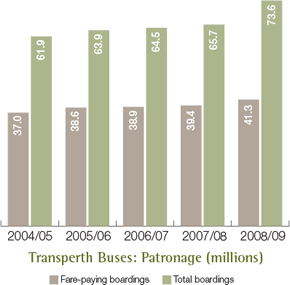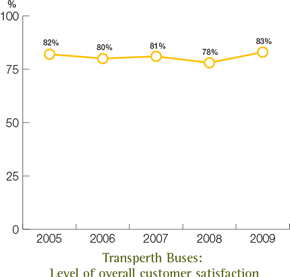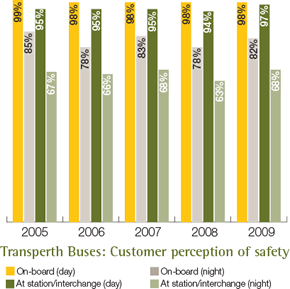Transperth Buses
Description of services
Transperth’s bus services are divided into 11 geographic contract areas, which are periodically subject to competitive tender. Currently three contractors operate the 11 contract areas
- Path Transit (Marmion-Wanneroo and Morley, with the Joondalup CAT contract forming part of the Morley contract)
- Swan Transit (Canning, Kalamunda, Midland, Southern River, Claremont and Belmont)
- Southern Coast Transit (Rockingham, Fremantle-Cockburn, and Perth CAT contracts, with the Fremantle CAT contract part of the Fremantle-Cockburn contract).
In 2008/09, the Transperth bus system operated 321 standard timetabled bus routes and 390 school routes. On a typical weekday this involved operating 11,458 standard service trips and 390 school service trips. Accessible buses are always used on 94 of the standard routes. A bus service frequency of 20 minutes or better is provided all day on most major corridors, with higher frequencies in peak periods.
The year’s developments
- Service improvements during the year:
- Introduced Route 79 on 28 July 2008, linking WSBS and QEII via the Esplanade Busport and UWA, to cater for the growing demand associated with expansion of the QEII/UWA precinct.
- Introduced Route 407 on 21 September 2008, linking Glendalough Station and the Herdsman Business Park. This route is jointly funded by Transperth and local business owners.
- Introduced improved evening peak and peak shoulder services on local feeder buses serving the Joondalup Line.
- Opened the new Welshpool bus depot on 1 July 2008, and purchased the Beckenham bus depot on 1 March 2009.
- Procured the third CNG articulated bus (Iveco) involved in the evaluation trial of new low-floor CNG articulated buses.
- Total service kilometres operated by the Transperth bus network continued to increase. In 2008/09, the network covered 51.997 million service kilometres, an increase of 2.1 per cent over the 50.923 million service kilometres operated in 2007/08, which represented an increase of 1.9 per cent over the previous year. In the five-year period to 2008/09, bus service kilometres have increased by seven per cent.
- Total capacity provided by the bus network also continued to increase. In 2008/09, Transperth provided 3690.9 million passenger place kilometres compared with 3637.6 million previously, an increase of 1.5 per cent following the 1.3 per cent increase in 2007/08.
- At 30 June 2009, Transperth operated 444 CNG buses in its fleet of 1134 buses. A further 80 CNG buses are due to be delivered in 2009/10 and another 74 in 2010/11, when the current bus supply agreement concludes.
- During the year, a CNG refuelling facility was under construction at Karrinyup bus depot and is due for commissioning in September 2009.
- The safety audits of Transperth’s bus contractors continued in line with standard AS 4801-OSH Management Systems. Each depot was audited at least once with other documented site visits occurring throughout the year. These regular audits and inspections have brought about improved safety management systems and safety focus by the contractors. The Lost Time Injury (LTI) rate for Transperth’s contractors continues to be well below the industry standard of 3.7.
- The safety standards of Transperth’s bus contractors continue to be high as reflected below:
- Swan Transit was re-certified to AS 4801 in May 2009. Swan has a reported LTI rate of 2.3.
- Path Transit has AS 4801 re-certification audits scheduled for July 2009 and has achieved the WorkSafe Platinum Award. Path has a reported LTI rate of 2.1.
- Southern Coast Transit was re-certified to AS 4801 in January 2008 and has achieved the WorkSafe Platinum Award. Southern Coast has a reported LTI rate of 2.0.
- The program to upgrade Transperth workshop facilities with a view to ensuring that maintenance of CNG-fuelled buses is carried out in a safe environment continued during the year. In addition to the installation of gas detection sensors at workshops, contractors have been provided with guidance on the requirements for safe-working procedures when carrying out maintenance on CNG buses.
Cost of the service
The total cost of operating Transperth bus services in 2008/09 was $303.532 million, 11.5 per cent more than the 2007/08 cost of $272.315 million. Operating costs increased 12.7 per cent to $254.501 million from $225.755 million.
The increase in bus operating costs was due mainly to an increase of 9.7 per cent in bus driver wages and the full-year cost impact of operating enhanced feeder services to the new Mandurah Line.
Patronage
Patronage on Transperth’s bus services recorded a significant increase in 2008/09. Total boardings increased by 12 per cent to 73.550 million from 65.694 million, and fare-paying boardings rose 4.8 per cent to 41.257 million from 39.361 million. The rates of growth in 2007/08 were 1.2 per cent for fare-paying boardings and 1.7 per cent for total boardings.
The increase in fare-paying boardings in 2008/09 was evenly distributed among the contract areas. However, Rockingham-Mandurah, where fare-paying boardings fell 6.4 per cent in 2007/08, recorded an increase of 14.9 per cent. In Southern River, fare-paying boardings increased by 9.3 per cent following the 7.7 per cent increase achieved in 2007/08. Fare-paying boardings in the Canning contract area continued to decline, falling 5.5 per cent following the 5.3 per cent decline in 2007/08. The popular Circle Route (a high-frequency bus service connecting major shopping centres, universities, schools and colleges) recorded an increase of five per cent compared to the small (0.4 per cent) increase in 2007/08.
Despite the recovery in the bus patronage growth rate, road congestion, particularly during peak periods, and the lack of significant bus priority measures on major roads in Perth, will continue to impact on service reliability and may affect patronage.
The significant growth in fare-paying boardings, combined with a relatively low rate of increase in service kilometres, resulted in fare-paying boardings per service kilometre rising 2.6 per cent from 0.773 in 2007/08, to 0.793. Total boardings per service kilometre increased 9.3 per cent from 1.29 to 1.41.
Passenger satisfaction
The 2009 Transperth PSM showed there was a significant increase in the proportion of users who expressed overall satisfaction with the bus system - 83 per cent compared with 78 per cent in 2008.
The importance rating of the key service characteristics of Transperth’s bus services (other than passenger safety) and the level of satisfaction for each key service characteristic are shown in the table opposite. In 2009, users identified "number of buses at weekends" as a key service characteristic replacing "driver’s manner", while the importance rating increased for "shelter provided at bus stop" and "availability of seats". The satisfaction rating for "punctuality of the bus", "cleanliness on board", "availability of seats" and "speed of trip" improved, while satisfaction declined in respect of "cost of fares" and "shelter at the bus stop". The level of dissatisfaction in regard to "number of buses at weekends" was very high at 45 per cent.
|
SERVICE CHARACTERISTIC |
IMPORTANCE RATING |
SATISFACTION RATING |
||
|---|---|---|---|---|
|
2008 |
2009 |
2008 |
2009 |
|
|
Punctuality |
71% |
65% |
77% (12%) |
83% (8%) |
|
Number of buses on weekdays |
64% |
64% |
69% (20%) |
69% (20%) |
|
Cost of fares |
61% |
61% |
70% (8%) |
66% (7%) |
|
Shelter provided at the bus stop |
49% |
59% |
72% (20%) |
71% (22%) |
|
Cleanliness on board |
53% |
55% |
90% (3%) |
91% (3%) |
|
Availability of seats |
45% |
49% |
91% (5%) |
92% (5%) |
|
Speed of the trip |
52% |
48% |
87% (5%) |
92% (3%) |
|
Number of buses on weekends |
43% |
38% (45%) |
||
Note: Dissatisfaction level shown in parenthesis.
Passenger safety
In the 2009 PSM, bus users were asked: "How safe do you generally feel from personal interference or threat from other passengers?"
The following graph shows the proportion of respondents who "always" or "usually feel safe" at the specified times/locations on the bus network.
The results for the past five years show that almost all bus passengers generally felt safe on buses and at station/interchanges during the day. There was a significant improvement in the proportion of users who generally felt safe at night on buses, 82 per cent in 2009 compared with 78 per cent in 2008, and at stations/interchanges, 68 per cent in 2009 compared with 63 per cent in 2008.
The security concerns expressed by passengers who use Transperth’s bus services at night have been given focussed attention. While noting that most passenger security concerns are based on perception rather than actual events, Transperth focussed even further attention on improving bus system security.
Improvements in recent years include:
- Two security officers deployed from Monday to Saturday at major bus stations during core hours.
- Mobile patrols deployed on each of the three major sectors - north, south and east - on busy nights of the week.
- Centrally-monitored CCTV at all bus stations.
- CCTV on all new buses in the fleet.
Major initiatives for 2009/10
- Commence a master plan for the introduction of a rapid transit system for Perth’s north-eastern corridor.
- Complete the master plan for the new underground bus station at Wellington Street.
- Complete the 20-Year Public Transport Blueprint for Perth.


